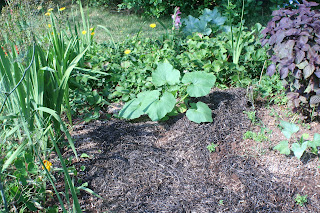Weeds come in a remarkable variety of shapes and sizes. But one thing is for sure. We will never get rid of them all. Their seeds can hide in the ground for many years, just waiting for us energetic gardeners to turn the soil and expose them to light so that they can germinate. Many send out runners above ground (hawkweed) or below ground (sheep sorrel - the worst weed offender in my garden). Others have roots so deep and persistant that they will produce a new plant from a tiny bit remaining in the ground.
Here are some of the weeds I deal with:
This is everybody's favourite - dandelion. The plant itself lives for many years, and produces hundreds of seeds every year. It blooms in spring, slows down in the summer, and then blooms and produces another crop of seeds in the fall. It's best to pull this guy after a rain, when the ground is soft enough to get the whole long root. Any root pieces left in the ground will produce a new plant, and a new headache for us.
This type of grass forms a clump which has courser, lighter-coloured leaves which stick out like a sore thumb. The only remedy is to dig out the whole clump and re-seed with lawn seed.
Hawkweed makes up a huge percentage of my lawn. It puts out runners which creep across the vegetable garden and flower beds. The yellow flowers and the seed heads look very much like dandelions.
Lamb's quarters, often afflicted by leaf miners, have more vitamin C and other nutrients than many of the vegetables we grow on purpose.
Another distiction - when is it a weed and when is it a wildflower? This is jewelweed, which produces lovely orange spotted flowers that hummingbirds love.
Queen Anne's Lace, a wild relative of the carrot, brightens up a drainage pipe. This plant is always alive with insects taking nectar from the flowers. I always spare a few to pretty up a bare spot.
Tuesday, August 21, 2012
volunteers in the garden
Is it a volunteer or is it a weed? When it's a plant in the wrong place, there is a fine line between the two.
A volunteer is a garden plant that has spread by seed or underground runner and has popped up in an unexpected place. A weed is just that - unwanted and unloved. With volunteers, I hesitate before I pull them out, because their effect can be unexpectedley lovely.
This pumpkin is a volunteer that sprang from a seed from a volunteer pumpkin that appeared in my garden last year. Welcome back!
A volunteer is a garden plant that has spread by seed or underground runner and has popped up in an unexpected place. A weed is just that - unwanted and unloved. With volunteers, I hesitate before I pull them out, because their effect can be unexpectedley lovely.
 |
I never could have purposely planted this apple mint between the cracks of this retaining wall and had it flourish. But that's exactly what it did on it's own.
|
 |
When putting together my containers, I ran out of purchased soil, and topped off this container with soil from the garden. Out popped a tomato seed that had waited all winter in the cold ground.
|
 |
I planted one sumac a few years ago. Now they are popping up all over the lawn. I hope to have a mini forest soon. They are easy to snip off if they become too many to be a good thing.
|
Friday, August 10, 2012
The best time to plant a tree is 20 years ago
Subscribe to:
Posts (Atom)














